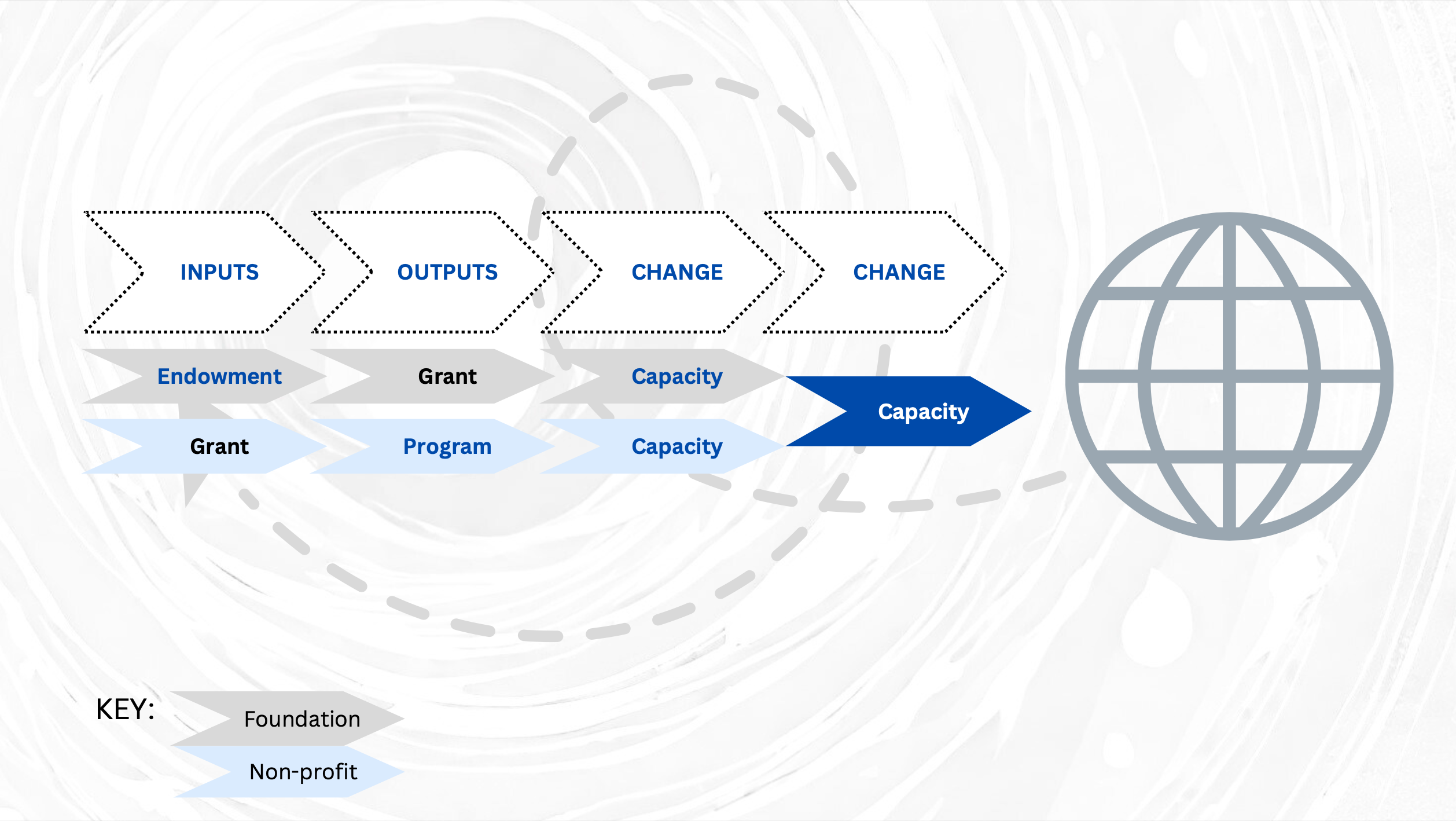The Foundation Data Dilemma: On Making and Measuring Change

Since attending and presenting at Exponent Philanthropy’s 2023 Annual Conference in October, I’ve spent some time reflecting on how foundations and non-profits relate to one another and engage in social change. In particular, I’ve been thinking about the challenges grant-makers experience in understanding and demonstrating the ‘difference’ they make. In my own session and in others, I was struck by two types of related, recurring questions about data and reporting.
The Anxiety of Data
One set of questions centered on grantees. What kind of data do foundations need and want to ask of their grantees? And in what amounts? These questions often reflected a concern about the ability of grantees to provide such data and the burden such requests might, therefore, represent. Some expressed discomfort with exercising this power over grantees and how it might reinscribe race, class, and gender dynamics they might otherwise seek to disrupt.
The other set of questions centered on the responsibility of fiduciaries: the family members or other trustees who authorize a foundation’s activities. What kind of data do they need and want to govern the allocation of their resources? Similarly, what kind of data do they need and want to have confidence in those who recommend such allocations and in those with whom they are entrusted? These questions, too, reflected considerations of power.
Privately, some professional staff expressed discomfort with the kinds and amounts of data their trustees wanted from grantees and the pace with which they wanted them. How to respect and meet the expectations of source funders, while minimizing the data burden on grantees—and, in some cases, honoring a commitment to do so? To be sure, it was not only professional staff who raised this issue. Several family members and other trustees expressed similar concerns, citing differing views and levels of influence within the boardroom.
The two sets of questions reflect an ambivalence—anxiety, even—about who is accountable to whom in the relationships that both constitute philanthropy and secure its social license. The foundational politics and ethics of these relationships are outside the present scope. Here, I would like to introduce a principle and a perspective that may nevertheless help some foundations negotiate them more transparently, simplify their approaches to data and reporting, and, in doing so, take steps to resolve the ‘data dilemma.’
Differentiating Roles
While private foundations in the US and the non-profits they support are considered the social ‘sector’ of the economy, the non-profits, rather than the foundations, typically perform the social work of that sector, mediating between those who have needs and those who have capital. The IRS codifies this expectation by distinguishing private foundations whose ‘primary activity [is] the making of grants to other charitable organizations,’ from public charities that engage in ‘the direct operation of charitable programs[1].’
In the present system, the role of private foundations is to fund non-governmental organizations (let’s call them non-profits) that provide public goods and services. Grant-making is the predominant mechanism by which foundations help enable non-profits to perform that work. This may all seem beyond obvious to any foundation that has ever made a grant and to any non-profit that has ever sought or received one. And yet, too often, it is a failure to adequately account for this core functional relationship that keeps foundations that want to acquire and learn from grantee data that are both meaningful and convenient from becoming foundations that do.
Understanding Impact
If we accept that the role of foundations is to help enable non-profits to perform their work, it follows that condition of non-profits—their capacity and capability to perform—should be their priority concern, both for what it can reveal about grant-making opportunities, and about their results. For example, financial security is essential for organizational performance over time. It can make the difference between retaining and losing staff, building and eroding trust with program recipients, seizing unexpected opportunities or stumbling when they arise. Understanding the role of a grant (or series of grants) in a non-profit’s financial security is therefore central to understanding the effectiveness of that grant or set of grants.
Other aspects of grantee capacity and capability are also important for understanding foundation impact. In addition to how well it is resourced, how well a non-profit is governed, managed, oriented, and informed will help determine how well it delivers on its social purpose. Foundations have a direct interest in the quality of their grantees along these organizational dimensions. While situations will vary (at any given time, for example, some non-profits may need to strengthen boards or executive offices; some may need to update or comply with existing financial policies and procedures; and others may need to evaluate or undertake new goals and strategies), it is the condition of their grantees that most directly attests to foundation performance.
The data foundations most need from grantees are data that indicate their relevant condition or conditions in the grant context. In some cases, those data may be financial. Perhaps funding helped a grantee update or meet cash reserve or employee compensation targets associated with financial resilience or attracting and retaining key staff. Or perhaps funding helped with the acquisition or development of other assets, such as board leadership and engagement, or a strategic plan and the readiness to carry it out. In such cases, foundations may find it helpful to consider data about board, staff, or other type of organizational development.

Meaningful Data Are Available
Regardless of the capacity or capability a given grant or set of grants may intend (or turn out) to address, the data that can best help foundations understand their results are, in fact, data that are likely most readily available to their grantees, from routine documents and materials such as budgets, calendars, and minutes. Indeed, foundations can typically access meaningful grantee data directly from public records, such as 990s—which, precisely because they reflect historical rather than contemporary data, represent an important resource for learning about outcomes as they show up over time.
This holds for data that may help illuminate the indirect effects of foundation funding too. How well, how much, or how long a given community, population, or environment is served by a grantee non-profit (or range of grantees and partners) is information all non-profits track, if by different methods and to different degrees. By asking grantees what they already count as evidence of their outcomes and supplementing that information with public data, foundations can reasonably extrapolate the field-level implications of their grant-making—their ultimate return on investment. Where gaps persist, foundations may perceive additional opportunities to invest and promote investment in the evaluation capacity and capabilities of individual grantees or grantee cohorts.
Addressing the Dilemma
Fundamentally, the ‘data dilemma’ is not about data volume, kind, or interpretation, although these are the registers in which it often presents. Sorting it out begins not by asking how much of which data foundations should ask of their grantees but by differentiating the role of each party in the shared project of social change.
Of course, differentiating roles doesn’t determine data. It doesn’t do away with the need for foundations and non-profits to identify their actual and aspirational capacities, capabilities, and results with specificity and evidence. It doesn’t make that work less important, less persistent, or less hard. It does lead to better questions at better times and opportunities to deduce and apply real learning. By recognizing grantees as their primary constituents and directing inquiry and investment accordingly, foundations can more justly exercise their most distinctive power to affect social change: helping non-profits realize their own.
About the Author
Deborah Chay is a principal with philanthropic and social sector advisory firm OE Consulting and leads its theory of change and evaluation practice.
[1] ‘Private foundations, in contrast [to public charities], typically have a single major source of funding (usually gifts from one family or corporation rather than funding from many sources) and most have as their primary activity the making of grants to other charitable organizations and to individuals, rather than the direct operation of charitable programs’. https://www.irs.gov/charities-non-profits/charitable-organizations/public-charities




Recent Comments